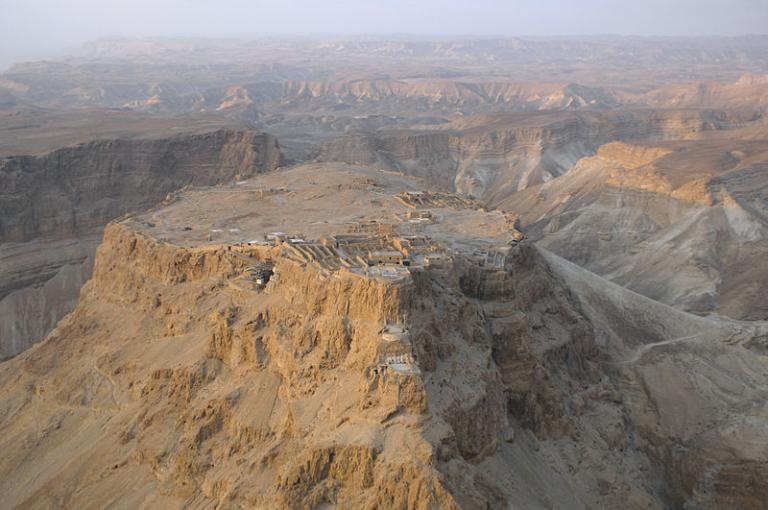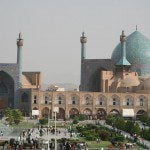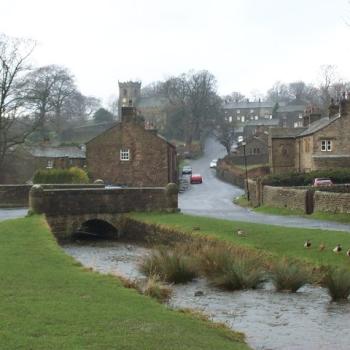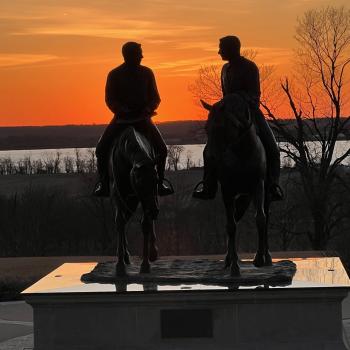
(Wikimedia Commons public domain image)
The last Jewish stronghold was the spectacular mountain fortress-palace of Masada, 1300 feet above the barren wilderness of the Dead Sea. It’s still possible today to stand upon Masada and see the outlines of the siege walls left behind by Flavius Silva and his Tenth Legion in the arid, hot soil. The Romans must have wondered just who was besieging whom. (Occasionally, the Jewish garrison on Masada would open up one of the cisterns of the fortress and let a cascade of water run down the side of the massive rock. This showed their enemies that they were comfortable and well supplied.) Still, while the Jews survived for a while and even thumbed their noses for a season at the Roman soldiers, time was again on Rome’s side.
The siege of Masada called for exactly the kind of military engineering at which the Romans were expert. With the forced assistance of thousands of Jewish prisoners of war, they built an immense ramp to the top of Masada that is still there today. The defenders of the fortress, unable to stop the ramp—and reluctant to fire upon their captive countrymen, who were building it—knew that the end was near. So, in a final act of defiance, they committed suicide. Nearly a thousand Jewish rebels died, including, perhaps, the last residents of the Essene community at Qumran. The Essenes had evidently sealed up their sacred records in the caves there and had retreated southward for a final stand against the Romans at Masada. Nearly two thousand years later, their documents would be discovered and become known to the world as the “Dead Sea Scrolls.” (The Nephite practice of sealing up important documents during periods of impending military disaster in the hope that they’ll come forth again at a later time—a practice much ridiculed when Joseph Smith revealed it to the modern world—now seems authentically ancient and Near Eastern.)
At the end of the revolt, the land was in ruins. Villages and cities were destroyed. Vast numbers of Jews were dead. Palestinian agriculture had suffered severely. The orchards of the hills and plains had been laid waste, sometimes by deliberate Roman policy and sometimes by the Jews themselves. Palestine’s persimmon groves, the only such groves in the world, were uprooted by Jewish rebels to prevent them from falling into the hands of the Romans.
However, this cataclysmic revolt that left Jerusalem destroyed and the holy temple in ruins—just as Jesus had said it would soon be—wasn’t the last Jewish rebellion against Rome. A revolt in Egypt lasted from 115 to 117 A.D. and crippled the Jewish community there. Jews were never again to be an important element in the life of the great ancient city of Alexandria. But Palestine, too, would see one more revolt: Astonishingly, the economy and the population of the Holy Land were able to bounce back by the end of the first century, so much so that the Jews were soon able to launch yet another suicidal war against the Roman Empire. This revolt broke out around 132 A.D. under the leadership of a guerrilla leader generally known as Simon bar Kokhba.[1] He enjoyed considerable early success. Simon drafted the local population into his army and gained control of the whole province of Judea, including Jerusalem. He even managed to secure much of the rest of the Holy Land. One entire Roman legion–the 22nd, based in and sent from Egypt–was annihilated. But, once again, the revolt’s ultimate fate was never really in question. Rome summoned its legions from as far away as Britain and the Danube frontier and concentrated them around Judea. As in the earlier rebellion, the Romans—eventually there were a full twelve legions of them, three times as many as Vespasian and Titus had commanded—proceeded slowly, methodically, through the countryside, destroying outlying points of resistance, dividing and conquering, using siege warfare to starve holdouts into submission. Galilee was lost to the Jews early on. From that point, the destruction and ruin of war were concentrated almost entirely on Judea itself. Some Jewish rebels attempted to hold Jerusalem, but it was hardly defensible because its walls had not been rebuilt since the last insurrection against Rome. Gradually, although they inflicted heavy losses upon their adversaries, the Jewish rebels were pushed back into the town of Betar in the Judean hills southwest of Jerusalem, where they fell to Roman forces in the summer of 135 A.D.
The Romans were much harsher this time than they had been in the Great Revolt of 66-70 A.D. Simon was killed in the siege of Betar, and the great Rabbi Akiva ben Joseph, the most illustrious scholar of his time, was tortured to death. (Rabbinic lore indicates that Akiva had not only supported Simon’s revolt but had pronounced Simon to be the Messiah.) Ancient sources speak of Jewish deaths numbering well above half a million, of nearly a thousand towns and villages being utterly destroyed. Unnumbered Jews were sold into slavery, and nearly all of Judea was left a wasteland. But the Romans’ losses had been heavy too, and when the emperor Hadrian reported to the Senate, he omitted the customary introductory phrase, “I trust you and your children are well; I and my troops are well.”[2]
In fact, Hadrian was furious. Personally hostile to Judaism because he found practices like circumcision disgusting and barbaric, he ordered the transformation of Jerusalem into a Greek-style pagan city, or polis. He used the debris of the old city to fill up the hollows and ravines of the site and to create a level platform upon which to build his new creation, which he named not Jerusalem but Aelia Capitolina, after his own family name and the name of the tutelary god of Rome. Hadrian transferred a population of Greek-speakers into the new city and forbade Jews to enter it on pain of death. The old official name of Judea was abolished and was replaced by the new name Syria-Palestina.[3] Thus ended what was definitively the last Jewish revolt against Rome.[4]
[1] There is some dispute about Simon’s name, but Bar Kokhba is the title by which he is most widely known. It means “Son of the Star” and is related to the words Kokob and Kokaubeam occurring in Abraham 3:13. Ancient Christian sources thought the title was given to Simon for its alleged messianic implications.
[2] Dio Cassius, Roman History, 59.
[3] This new name represented a lingering memory of the ancient Philistines and may have been especially (and intentionally) galling to the Jews.
[4] In 1961, the great Israeli archaeologist Yigael Yadin found a land deed connected with the Bar Kokhba revolt in a place not far from the Dead Sea called the Cave of Letters. See Yigael Yadin, Bar-Kokhba (New York: Random House, 1971), 176. This document is of considerable interest for Latter-day Saints, since it was signed by one “Alma the son of Judah.” The Nephite masculine name Alma has occasioned much ignorant laughter among anti-Mormons, but it is now known to be authentically ancient and authentically Jewish. How, though, could Joseph Smith have known that? See Hugh Nibley, The Prophetic Book of Mormon, Volume 8 in the Collected Works of Hugh Nibley (Salt Lake City and Provo: Deseret Book and the Foundation for Ancient Research and Mormon Studies, 1989), 281-82. Nibley offers a discussion of Bar Kokhba at pp. 274-88 of the same volume in a book review that originally appeared in Brigham Young University Studies 14 (Autumn 1973), 115-26.












